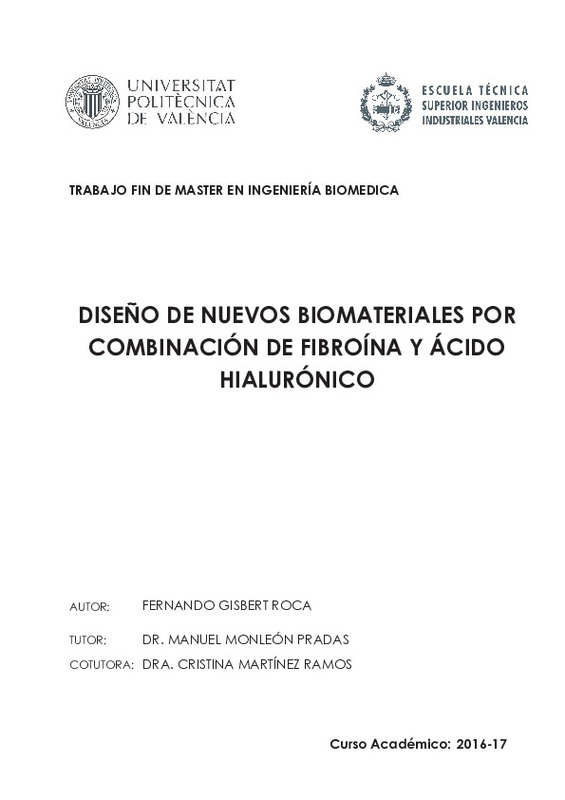JavaScript is disabled for your browser. Some features of this site may not work without it.
Buscar en RiuNet
Listar
Mi cuenta
Estadísticas
Ayuda RiuNet
Admin. UPV
Diseño de nuevos biomateriales por combinación de fibroina y ácido hialurónico
Mostrar el registro sencillo del ítem
Ficheros en el ítem
| dc.contributor.advisor | Monleón Pradas, Manuel
|
es_ES |
| dc.contributor.author | Gisbert Roca, Fernando
|
es_ES |
| dc.date.accessioned | 2018-01-09T16:00:16Z | |
| dc.date.available | 2018-01-09T16:00:16Z | |
| dc.date.created | 2017-07-27 | |
| dc.date.issued | 2018-01-09 | es_ES |
| dc.identifier.uri | http://hdl.handle.net/10251/94285 | |
| dc.description.abstract | [ES] Las lesiones y enfermedades que afectan al sistema nervioso, tanto central (SNC) como periférico (SNP), poseen incidencias y prevalencias muy elevadas, afectando a millones de personas en todo el mundo. Además, el hecho de que la regeneración autónoma del sistema nervioso sea bastante limitada, especialmente en el SNC, hace que la pérdida de funciones tanto motoras como sensitivas asociada a estas afecciones persista de por vida. Con el objetivo de mejorar las limitadas terapias actuales de reparación y regeneración en este campo se ha desarrollado la ingeniería tisular del sistema nervioso, la cual trata de encontrar estrategias de reparación alternativas mediante la combinación de la terapia celular, moléculas bioactivas y andamiajes basados en biomateriales. El presente Trabajo Fin de Máster se enmarca dentro de este campo, más concretamente en la producción de conductos de guía nerviosa (NGCs) capaces de favorecer la regeneración de tractos axonales tanto del SNC como del SNP. Estas estructuras se han producido mediante la combinación de ácido hialurónico (HA) y fibroína de seda (SF) con el objetivo de lograr mejorar sus propiedades tanto de manipulabilidad como de adhesión y proliferación celular a la vez que se mantienen las buenas propiedades morfológicas de los NGCs basados únicamente en HA. Los resultados obtenidos muestran que la incorporación de la SF al proceso de producción ha sido satisfactoria, obteniendo NGCs con una estructura tubular adecuada que presentan una superficie interna lisa que favorece la adhesión celular y unas paredes con la porosidad adecuada para permitir la difusión de nutrientes y oxígeno. Asimismo se observó una mejora tanto de las propiedades mecánicas del material, la cual ayudará a su manipulación en futuras etapas in vitro e in vivo, como de las propiedades de adhesión y proliferación celular, la cual permitirá mejorar la biofuncionalización del interior del conducto con células de soporte gliales. | es_ES |
| dc.description.abstract | [EN] Injuries and diseases affecting the nervous system, both central (CNS) and peripheral (PNS), have very high incidence and prevalence, affecting millions of people around the world. Moreover, the fact that autonomous regeneration of the nervous system is rather limited, especially in the CNS, causes the loss of both motor and sensory functions associated with these conditions to persist for life. In order to improve the limited current repair and regeneration therapies in this field, tissue engineering of the nervous system has been developed, which seeks to find alternative repair strategies by combining cell therapy, bioactive molecules and scaffolds based on biomaterials. This Master Thesis is included in this field, more specifically in the production of nerve guidance conduits (NGCs) capable of promoting the regeneration of axonal tracts in both the CNS and the PNS. These structures have been produced by the combination of hyaluronic acid (HA) and silk fibroin (SF) with the aim of improving their properties of both manipulability and cell adhesion and proliferation while maintaining the good morphological properties of NGCs based solely on HA. The results show that the incorporation of SF into the production process has been satisfactory, obtaining NGCs with a suitable tubular structure that present a smooth internal surface that favors the cell adhesion and walls with the adequate porosity to allow the diffusion of nutrients and oxygen. It was also observed an improvement in the mechanical properties of the material, which will help to its manipulation in future in vitro and in vivo stages, as well as an improvement in the cell adhesion and proliferation characteristics, which will help to improve the biofunctionalization of the inner conduit with glial support cells. | es_ES |
| dc.language | Español | es_ES |
| dc.publisher | Universitat Politècnica de València | es_ES |
| dc.rights | Reserva de todos los derechos | es_ES |
| dc.subject | Nervous system regeneration | es_ES |
| dc.subject | Tissue engineering | es_ES |
| dc.subject | Nerve guidance conduit | es_ES |
| dc.subject | Biomaterials | es_ES |
| dc.subject | Hyaluronic acid | es_ES |
| dc.subject | Silk fibroin. | es_ES |
| dc.subject | Regeneración del sistema nervioso | es_ES |
| dc.subject | ingeniería tisular | es_ES |
| dc.subject | conducto de guía nerviosa | es_ES |
| dc.subject | biomateriales | es_ES |
| dc.subject | ácido hialurónico | es_ES |
| dc.subject | fibroína de seda. | es_ES |
| dc.subject.classification | MAQUINAS Y MOTORES TERMICOS | es_ES |
| dc.subject.other | Máster Universitario en Ingeniería Biomédica-Màster Universitari en Enginyeria Biomèdica | es_ES |
| dc.title | Diseño de nuevos biomateriales por combinación de fibroina y ácido hialurónico | es_ES |
| dc.type | Tesis de máster | es_ES |
| dc.rights.accessRights | Abierto | es_ES |
| dc.contributor.affiliation | Universitat Politècnica de València. Departamento de Termodinámica Aplicada - Departament de Termodinàmica Aplicada | es_ES |
| dc.contributor.affiliation | Universitat Politècnica de València. Escuela Técnica Superior de Ingenieros Industriales - Escola Tècnica Superior d'Enginyers Industrials | es_ES |
| dc.description.bibliographicCitation | Gisbert Roca, F. (2017). Diseño de nuevos biomateriales por combinación de fibroina y ácido hialurónico. http://hdl.handle.net/10251/94285 | es_ES |
| dc.description.accrualMethod | TFGM | es_ES |
| dc.relation.pasarela | TFGM\70900 | es_ES |
Este ítem aparece en la(s) siguiente(s) colección(ones)
-
ETSII - Trabajos académicos [10404]
Escuela Técnica Superior de Ingenieros Industriales






